This report analysed the seaweed-carrageenan value chain in the Takalar region of South Sulawesi province, Indonesia, a region that produces about 20 percent of the world’s supply of carrageenan seaweed. Seaweed production contributes to the livelihoods of thousands of farmers and traders in South Sulawesi.
We aimed to document the relationships and interactions between the different actors, understand the prices and costs within the value chain and explore opportunities to increase the incomes of seaweed farmers and traders. To achieve these objectives, we investigated various aspects of the seaweed production process, cost and price structures and relationships between different actors in the value chain, including farmers, traders and processors.
RELEVANT SUSTAINABLE GOALS



By analysing the value chain of seaweed-carrageenan, we are able to provide a number of insights. These include the relationships and interactions between actors in the value chain, quantitative primary data on the prices and costs within the value chain and opportunities to increase the incomes of seaweed farmers and traders. The insights have led us to a number of recommendations:
1. The establishment of farmer groups or cooperatives and micro-credit schemes to improve seaweed production and prices obtained. Cooperatives would help improve farmer incomes and assist with providing extension services for disease control, drying and storing facilities and reducing farmers’ dependence on credit for seedlings. Farmers have sometimes relied on close relationships with traders in order to secure credit for buying seedlings and the establishment of cooperatives is likely to contribute to a more transparent and fairer arrangement.
2. The government helps provide market price information. Price information flows from processors to traders to farmers can be opaque and confusing; processors of seaweed often struggle to make a profit due to price volatility and rising costs of raw dried seaweed. Better access to market information would assist processors in coping with price volatility.
3. We recommend using a marketing margin framework to evaluate options for enhancing profits along the value chain. Effectively evaluating market displacements, or distortions, requires an improved understanding of factors such as total annual production of raw dried seaweed, the price elasticity of seaweed supply, the price elasticity of carrageenan demand and quantitative data on competition between value chain actors and market power.
The complexity of the seaweed value chain becomes apparent in this report as well as the importance of collaboration between all the people involved in it to improve seaweed industry profitability and sustainability in Takalar Regency. Policymakers can play a critical role by providing better information and support.
Feature image by PAIR
You may also be interested in :
Call for Decade Actions on Sustainable Blue Foods & Ocean Economy


